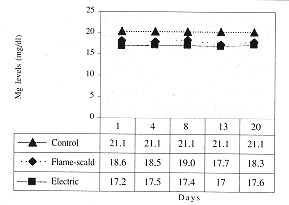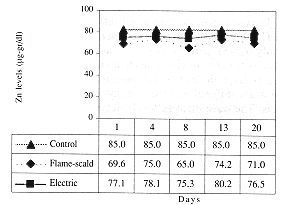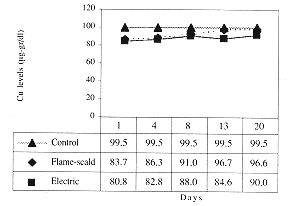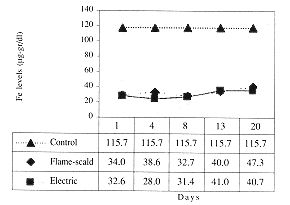Annals of
Burns and Fire Disasters - vol. XII - n° 3 - September 1999
EXAMINATION OF SERUM ZINC,
COPPER, MAGNESIUM, AND IRON LEVELS IN PATIENTS WITH ELECTRIC AND FLAME/SCALD BURNS
Gümüs N., Safran Z.B., Acarturk S.,
Abdülrezzak A.
Burn Unit of Plastic and Reconstructive
Surgery Department, Faculty of Medicine, Qukurova University, Adana, Turkey
SUMMARY. In
this study, 5 cc venous blood samples were taken on the Ist, 4th, 8th, 13th, and 20th days
post-burn from 17 patients with high-tension electric burns, 14 with flame burns, and one
with scald burns. Scrum zinc, copper, magnesium, and iron levels were determined using an
atomic absorption spectrophotometer. Venous blood samples were taken from 20 healthy
volunteers as control levels for these elements. The results were evaluated using the
Mann-Whitney U test. On each day the serum levels of the elements were found to be
significantly lower than those of the control group (p < 0.05). The element levels in
the electric burn patients were also markedly lower than those in the healthy group (p
< 0.05). A comparison of the element levels in the flame and scald burn patients with
those of the electric burn patients by means of the Mann-Whitney U test did not reveal any
differences (p > 0.05).
Introduction
Trace elements are inorganic
substances found in human blood in the order of micrograms. These elements are
incorporated into the structures of proteins, enzymes, and complex carbohydrates. They
take part in biochemical reactions together with enzymes. Zinc (Zn) and copper (Cu) are
especially active in metabolic and biochemical processes in the recovery phase of wounds.
It is known that the trace elements are necessary for the continuous systematic
functioning of the immune system." Magnesium (Mg) is required for the synthesis of
all proteins, nucleic acids, nueleotides, lipids, and carbohydrates, as also for the
contraction of muscles. Iron (Fe), apart from its presence in all body cells, plays a role
in the oxygenation of tissues as it is incorporated in the haeme structure of haemoglobin.
Burns, a pathology characterized by injury and loss of the organism's largest organ, is a
condition in which there is an increase in certain metabolic processes, such as tissue
repair, wound healing, microcirculation, and oxygenation. The elements that take part in
these processes are of primary importance to the burn patient.
In this study, serum Zn, Cu, Mg, and Fe levels in electrically burned patients and in
others with scald burns due to hot liquids and flames were determined and the effect of
the burns on the serum levels of these elements was investigated.
Materials and methods
The study was conducted prospectively
between January 1996 and September 1998 at the Burn Unit of the Cukurova University,
Department of Plastic and Reconstructive Surgery Faculty of Medicine. Seventeen
high-tension electrically burned patients, 14 with flame burns, and one with scald burns
were included in the study. Serum trace element levels obtained from 20 healthy adults
were used as controls. All the patients but one were male. The average age of the
electrically burned patients was 25.1 ± 13.3 yr and that of the flame and scald burned
patients 34.2 ± 13.0 yr. In the control group the average age was 33.8 ± 12.6 yr. The
average burned body surface area was 20.9 ± 11.2% in the electrically burned patients and
36.1 ± 16.6% in the flame and scald burn patients. Patients who reported to our emergency
service in the first 24 It after the burn were admitted to our burn unit. In all patients
an intravenous way was accessed and fluid treatment was initiated based on the Parkland
fonnula. A urinary catheter was put in place and the hourly urine output was monitored.
The patients' vital signs, urinary output, and haematuria were also monitored and
appropriate fluid was added accordingly. In the high-tension electrical burn patients
fasciotomy was performed when the development of compartment syndrome in the limb was
considered likely, in order to free the extremity. Routine wound care and dressings were
applied in the treatment of the burn wounds.
On the 1st, 4th, 8th, 13th, and 20th days after the burn, 5 cc of venous blood were taken
from each patient. Testtubes, previously washed with citrate and dried, were filled with
the blood samples and submitted to the research laboratory of the Basic Medical Sciences,
Cukurova University Faculty of Medicine. The sera were then separated by centrifugation,
and the serum Zn, Cu, Mg, and Fe levels were determined using an atomic absorption
spectrophotometer. The normal levels of these elements were determined on the basis of
venous blood samples obtained from the 20 healthy adult volunteers. The results were
evaluated using the Mann-Whitney U test.
Results
The average trace element values of
the patients with flame and scald burns were determined 1, 4, 8, 13, and 20 days
post-burn. The average Mg levels were respectively 18.6 ± 2.1, 18.5 ± 1.9, 19.0 ± 2.1,
17.7 ± 1.4, and 18.3 ± 1.2 mg/dl (Fig. 1). The average Zn levels for the
respective sampling days were 69.6 ± 11.7, 75 .0 ± 23.3, 65.0 ± 12.8, 74.2 ± 25.6, and
71.0 ± 17.8 ~g/dl (Fig. 2).
 |
 |
| Fig. 1
- Serum Mg levels in healthy persons and patients with electric or flame/scald burn on
respective sampling days. |
Fig. 2
- Serum Zn levels in healthy persons and patients with electric or flame/scald burn on
respective sampling days. |
|
The average Cu levels for
the respective days were 83.7 ±15.6, 86.3 ± 19.9, 91.0 ± 15.9, 96.7 ± 15.2, and 96.6
± 16.9µg/dl (Fig. 3). The levels for Fe were 34.0 ± 24.2, 38.6 ± 22.6, 32.7 ±
19.6, 40.0 ± 30.7, and 47.3 ± 21.4 µg/dl respectively (Fig. 4).
 |
 |
| Fig. 3
- Serum Cu levels in healthy persons and patients with electric or flarne/scatcl burns on
respective sampling days. |
Fig. 4
- Serum Fe levels in healthy persons and patients with electric or flame/scald burn on
respective sampling days. |
|
The trace element levels
for the electrically burned patients on the Ist, 4th, 8th, 13th, and 20th days were as
follows: average Mg levels, 17.2 ± 2.2, 17.4 ± 2.7, 17.4 + 2.7, 17.0 ± 2.5, and
17.6 ± 2.8 mg/dl respectively; average Zn levels, 77.17 ± 24.5, 78.1 ± 29.6, 75.3 ±
24.5, 80.2 ± 37.0, and 76.5 ± 32.0 µg/dl respectively; average Cu levels, 80.8 12.9,
82.8 ± 15.4, 88.0 ± 27.4, 84.6 ± 20.3, and 90.0 20.3 µg/dl respectively (Figs.
1-3). The Fe levels for the respective days were 32.6 ± 19.4, 28.0 21.6, 31.4 ±
18.5, 41.0 ± 16.9, and 40.7 ± 19.0 g/dl (Fig. 4).
The average Mg, Zn, Cu, and Fe levels in the venous blood samples of the healthy adult
volunteers were respectively 21.1 ± 1.9 mg/dl, 85.0 ± 12.1 µg/dl, 99.5 ±10.9 µg/dl,
and 115.7 ± 41.7 µtg/dl.
The values obtained on the respective sampling days for the elements in the flame and
scald burn patients were compared statistically with those of the electrically burned
patients using the Mann-Whitney U test. After separate evaluation of the various elements,
no significant difference was found (p > 0.05). The average Mg, Zn, Cu, and Fe levels
in the venous blood of the flame and scald burn patients were also statistically compared
with those of the control group, using the Mann-Whitney U test. For all the elements as a
whole, the difference between the groups was found to be significant (p < 0.05). A
cornparison, using the Mann-Whitney U test, of the trace element levels in the electric
burn patients with those of the control group showed a statistically significant
difference (p < 0.05).
Discussion
The average percentage of the burned
body area in our electric burn patients was 20.9 ± 11.2%, compared with 36.1 ± 16.6% of
the flame and scald burn patients. The percentage burn of our electric burn patients was
markedly lower than the burn area in the flame and scald burn patients. Necrosis could be
seen in the subcutaneous tissue, muscles, nerves, vessels, and bone tissues. For this
reason, although the percentage burn was low in high-tension electric burns the damage was
serious and deep. Despite the fact that these patients reported to our clinic on the
first, day of their burns and fasciotomy was performed, in some patients necrosis of the
limb could not be prevented. In electrical burns of the limbs, from the early stage
necrotic tissue was removed by serial debridement. However, in 35.3% of the patients
amputation of the limb was still inevitable. In a study by Achauer et al. in which 22
patients with electric burns of the upper limbs were examined, it was shown that 40% of
the cases required amputation. This was a retrospective study covering 10 years.
In all of the burn patients Zn, Cu, Mg, and Fe levels were determined on the Ist, 4th,
8th, 13th, and 20th days. Statistical evaluation by the Mann-Whitney U test of the average
trace element levels according to the sampling days for the electric and flame/scald burn
patients showed no comparative differences (p > 0.05). This observation shows that
although they have different aetiologies the pathogenesis of burns remains unchanged. This
is because in the organism a mechanism other than that of the heat effect of the electric
flow, and especially the effect of high voltage, is responsible for the damage. The serum
element levels would be expected to differ significantly. Our findings, however, show that
the electric flow had no effect different from other aetiologies of burns on the serum
trace element levels. Despite the marked difference in the percentage of body burns, the
finding that there was no difference in the trace element levels shows that the trace
element levels changed as a result of the systemic effect of the burns. After the burn,
trace element excretion was shown to occur from the wound surface and in the urine. Whilst
the serum levels of Zn and Cu fall, it is known that its excretion by the urine increases.
Whilst the serum concentration of Cu is reported to be inversely proportional to the burn
surface, serum Zn concentration is not affected.' With an increase in the surface burned,
it is known that Fe levels fall due to coagulation of blood cells and increased
haernaturia. All these findings show the important effect of burn wounds on serum trace
element levels.' The serum Zn, Cu, Mg, and Fe levels determined in the 20 healthy
volunteers in the control group were compared statistically with the values of the
electric burn and flame/scald burn patients, using the Mann-Whitney U test. In both groups
a significant difference was shown (p < 0.05). Irrespective of aetiology, the serum
trace element levels were lower in the burn patients than in the healthy individuals. This
result is consistent with other studies in the literature. Several factors affect the
return of the reduced serum trace element levels to normal. First of all, the increased
intake of the elements, nutritional support, parenterally administered fluids, plasma, alburnin,
and globulin and blood transfusions affect the blood levels of the elements. The most
important factor however, is the healing of the burn wound.
In conclusion, no significant difference in the serum Zn, Cu, Mg, and Fe levels was
determined between electrically burned patients and flame and scald burn patients. Between
the control group, made up of healthy adults, and the patients with electric and
flame/scald burns there were significant differences in the serum Zn, Cu, Mg, and Fe
levels. The trace element levels decreased in all the burn patients, irrespective of
aetiology.
RESUME. Cette étude
considère 32 patients brûlés, dont 17 par electricité à haute tension, 14 par flammes
et un par ébouillantement. Des prélèvements de sang veineux (5 cc) ont été effectués
le premier, 4ème, 8ème, 13ème et 20ème jour après la brûlure. Les niveaux de zinc,
cuivre, magnésium et fer sérique ont été detenninés avec l'emploi d'un
spectrophotomètre d'absorption atomique. Des prélèvements de sang veineux obtenus dans
20 volontaires sains ont été utilisés comme valeurs témoins. Les résultats ont été
évalués avec le test U de Mann-Whitney. Les Auteurs ont trouvé que les niveaux
sériques des éléments, tous les jours, étaient significativement inférieurs aux
valeurs présentées par le groupe témoin (p < 0,05). Aussi les niveaux des éléments
dans les patients atteints de brûlures électriques étaient notamment inférieurs aux
valeurs du groupe sain (p < 0,05). La comparaison entre les niveaux des éléments dans
les patients atteints de brûlures par flamme et par ébouillantement et ceux des patients
atteints de brûlures électriques, effectuée en utilisant le test U de Mann-Whitney, n'a
révélé aucune différence W < 0,05).
BIBLIOGRAPHY
John H., Marion S.: Zinc concentrations
within healing wounds. Arch. Surg., 100: 349-57, 1970.
- Selmanpakoilu A. N., Cetin C., Sayal A.: Trace element (Al, Se, Zn, Cu) levels in serum,
urine and tissues of burn patients. Burns, 20: 99-103, 1994.
- Gosling P., Rothe H.M.: Serum copper and zinc concentration in patients with burns in
relation to burn surface area. J. Burn Care Rehabil., 16: 481-6, 1995.
- Berger M.M., Cavadini C.: Unrecognised intake of
trace elements in polytraurnatized and burned patients. Ann. Fr. Anesth. Reanim., 13:
289-96, 1994.
- Moylan J.A.: Burn injury. In: Gregory S.G., Nicholas G.G. (eds), Textbook of Plastic,
Maxillofacial and Reconstructive Surgery (2nd ed.), Williams and Wilkins, Baltimore, 243,
1992.
- Press B.: Thermal electrical and chemical
injuries. In "Grabb and Smith's Plastic Surgery", Aston S.J., Beasley R.W.,
Thorne H.C. (5th ed.), Lippincott-Raven, New York, 161-91, 1997.
- Achauer B., Applebaum R., Vander Kam V.M.: Electrical burn injury to the upper
extremity. Br. J. Plast. Surg., 47: 331-40, 1994.
- Berger M.M., Cavadini C.: Influence of large intakes of trace elements on recovery after
major burns. Nutrition, 10: 327-34, 1994.
- Raff T., Hartman B.: Early intragastric feeding of
seriously burned and long term ventilated patients: A review of 55 patients. Burns, 23:
19-25, 1997.
- Rodriguez D.J.: Nutrition in patients with severe burns: State of the art. J. Burn Care
Rehabil., 17: 62-70, 1996.
- Cucchiara P., Masellis M., Sucameli M.:
Considerations on nutritional therapy in the burn patient. Ann. Burns and Fire Disasters,
9: 30-2, 1996.
- Holland K.A., Gillespie R.W.: Estimating energy
needs of pediatric patients with burns. J. Burn Care Rehabil., 16: 458-60, 1995.
| This paper was received on 1 April 1999. Address correspondence to:
Dr Nazim Gumus
Mahfesigmaz mah. 69 sok. Yucel Sitesi E blok Kat: 8, No. 24
Adana, Turkey. |
|



